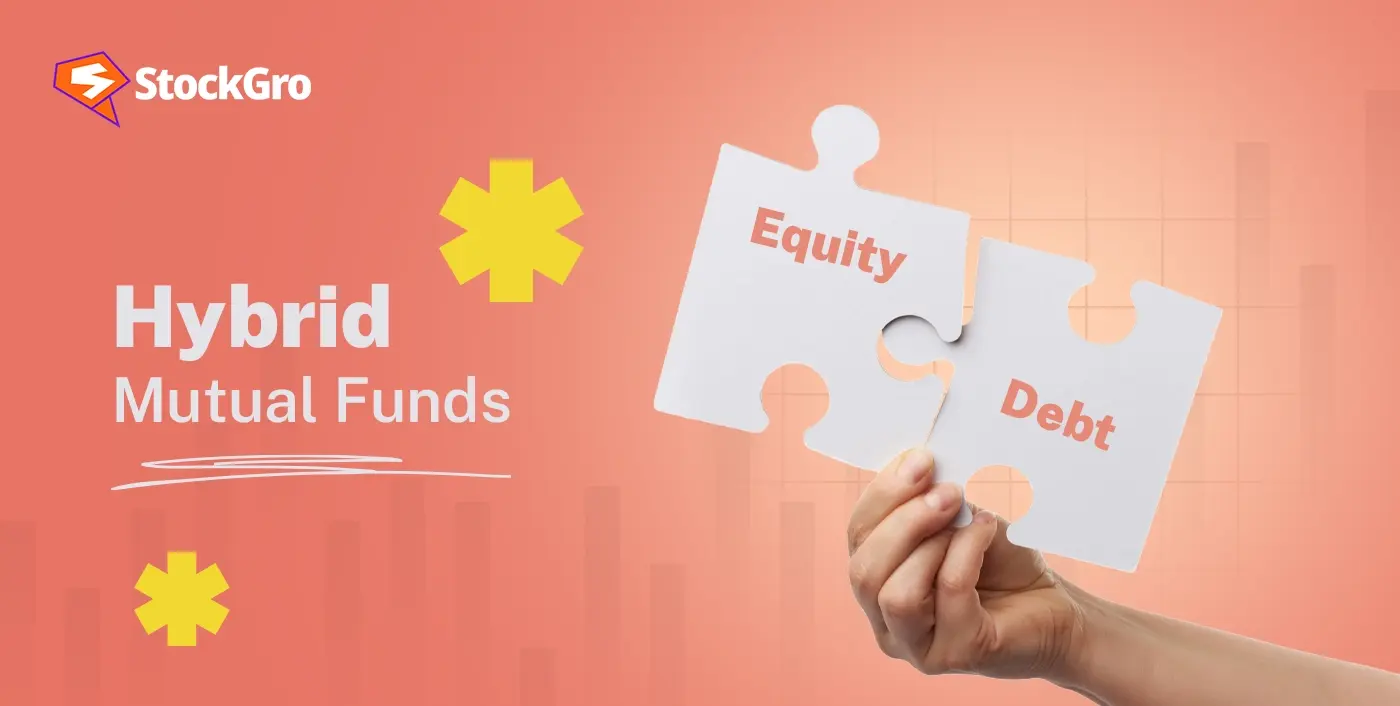
Feeling unsettled by the wild ups and downs of 2025 markets? Swift changes in equity and debt prices can make it hard to plan your investments with confidence. Hybrid mutual funds combine both in one place, helping you handle these shifts better.
More and more people are choosing this option to keep their money growing without relying on just one type of asset. In fact, hybrid fund assets grew by 3.55% in April 2025 to ₹9.15 lakh crore, displaying how many people see them as a practical choice. Now, let’s learn about these funds in detail!
What are hybrid mutual funds?
Hybrid mutual funds are mutual fund schemes that invest in a mix of asset classes, primarily equities (stocks), debt (bonds), and sometimes other assets like gold or real estate. Their diversification aims to balance risk and reward, offering growth potential from equities and stability from debt instruments, making them suitable for a variety of risk profiles. Some of their primary features include:
- Diversification across asset classes reduces risk.
- Professional fund management and automatic rebalancing.
- Suitable for conservative, moderate, and aggressive investors.
- Potential for steady returns with lower volatility compared to equity funds.
- Flexibility to choose based on risk appetite and investment goals.
SEBI has classified hybrid funds into 7 subcategories. Each designed for specific risk levels and investment goals, as discussed below.
| Type | Allocation range | Pattern |
| Conservative hybrid fund | Equity: 10%–25%Debt: 75%–90% | Focuses on stability with limited equity exposure. |
| Balanced hybrid fund | Equity & Debt: 40%–60% each | Equal exposure to equity and debt for balanced risk. |
| Aggressive hybrid fund | Equity: 65%–80%Debt: 20%–35% | Higher growth potential with moderate risks |
| Dynamic asses allocation/Balanced advantage fund | Equity & Debt: 0%–100% | Allocation changes dynamically with market conditions. |
| Multi asset allocation fund | Min. 10% in three assets | Invests in at least three asset classes (e.g., equity, debt, gold.) |
| Arbitrage fund | Equity (hedged): min 65% | Uses arbitrage for low-risk, tax-efficient returns. |
| Equity savings fund | Equity: min 65%Debt: min 10% | Mixes equity, debt, and derivatives for hedging. |
Also read: Fair market value: Impact on stock and mutual fund investments
Understanding hybrid funds performance in market downturns
When markets turn turbulent, hybrid mutual funds hold strong, here’s the reasons how:
- Debt component provides a safety net and reduces volatility
Hybrid funds invest in a mix of equity and debt, with the debt portion acting as a stabilizer. This inclusion of more stable debt assets helps to mitigate sharp market swings and reduce the overall volatility of the fund. The consistent returns from debt can offset potential losses from the equity component, offering a smoother investment experience compared to pure equity funds.
- Lower drawdowns compared to pure equity funds
The inherent diversification and the presence of debt assets provide significant drawdown protection. This means that during market corrections or downturns, hybrid funds tend to experience smaller declines in value than pure equity funds.
This reduced downside risk helps investors stay invested and less stressed, preventing panic selling and supporting long-term financial goals.
- Dynamic asset allocation reduces risk
Many hybrid funds, particularly balanced advantage funds, employ dynamic asset allocation strategies. They automatically adjust their equity and debt allocations based on market conditions, valuations, and predefined models.
This proactive rebalancing helps to de-risk the portfolio during overvalued market phases and selectively increase equity exposure when opportunities arise.
You may also like: Gold Outshines Equities in 2024: A Look at the Drivers
Are hybrid funds safe? Know the details
Understanding are hybrid funds safe begins with comprehending these key points:
- Stricter F&O limits reduce speculation and improve safety
SEBI’s new F&O rules in 2025 are designed to align derivatives exposure with actual market liquidity and curb excessive speculation in stocks with low trading volumes. The revised Market Wide Position Limit (MWPL) now ties F&O exposure to the lower of 15% of free-float shares or 65 times the average daily delivery value, with a floor of 10%. For hybrid funds that use derivatives for hedging or arbitrage, these rules mean stricter compliance and potentially lower risk of market manipulation, enhancing overall portfolio stability and investor protection.
- SEBI planning new rules to enhance portfolio safety and transparency
SEBI is planning to implement new regulatory updates that tighten rules for mutual funds, including hybrid schemes. It will require the regulator to ensure prompt rebalancing of portfolios if asset allocations breach mandated limits, and has enhanced disclosure norms for all mutual funds. These measures will be designed to make mutual funds including hybrid funds more transparent, disciplined, and investor-friendly, reducing the risk of mismanagement and ensuring that funds remain true to their stated investment strategy.
- Debt component adds stability
Hybrid funds invest in both equity and debt, with the debt portion acting as a stabilizer during market volatility. However, aggressive hybrid funds, which allocate a higher proportion to equities (as per SEBI norms, 65–80% in stocks), can still experience significant fluctuations during market downturns. While the debt allocation cushions losses, the equity component means these funds are not immune to market risks
To know more: Mutual funds or stocks: Which is a better investment?
Recent performance trends in 2025
Now that you know how hybrids work and how they can be a potential option in market downtime, take a look at how each category performed recently.
| Category | 1 Year (%) | 3 Years (%) | 5 Years (%) |
| Hybrid: Aggressive Hybrid | 6.52 | 18.65 | 19.05 |
| Hybrid: Balanced Hybrid | 7.41 | 13.37 | 12.69 |
| Hybrid: Conservative Hybrid | 7.45 | 10.58 | 9.68 |
| Hybrid: Equity Savings | 7.01 | 11.38 | 11.27 |
| Hybrid: Arbitrage | 6.71 | 6.66 | 5.32 |
| Hybrid: Dynamic Asset Allocation | 5.87 | 14.78 | 14.05 |
| Hybrid: Multi Asset Allocation | 8.94 | 17.59 | 17.73 |
Conclusion
Hybrid mutual funds combine equity and debt to offer balanced growth with reduced volatility. With SEBI’s stricter rules enhancing safety, they remain a smart choice in today’s markets. If you’re looking for stability without giving up on returns, keeping an eye out for the best hybrid mutual fund could be a great step toward meeting your investment goals.
FAQ‘s
SIP is a disciplined approach that can be used for both equity and hybrid funds. SIPs in equity funds generally offer higher long-term growth but come with greater volatility, while SIPs in hybrid funds provide more stability due to their debt component. The choice depends on your risk preference and investment pattern, hybrid SIPs suit those seeking moderate risk and smoother returns, while equity SIPs are better for those comfortable with higher risk and aiming for maximum growth.
Hybrid funds, despite offering diversification, are not free from risks. The equity portion exposes investors to market volatility, and the debt component carries interest rate and credit risks. Aggressive hybrid funds, in particular, can experience significant drawdowns during sharp market corrections. Moreover, returns from hybrid funds may lag behind pure equity funds in strong bull markets. They are also subject to regulatory changes and periodic rebalancing, which can affect performance.
Hybrid mutual funds generally do not have a mandatory lock-in period imposed by SEBI. Investors typically have the flexibility to redeem their units at any time, subject to the fund house’s exit load policy, if any. However, it’s crucial to distinguish these from “Solution Oriented Schemes” like retirement or children’s funds, which invest across asset classes including hybrid strategies. These schemes, as per SEBI, accompany a statutory lock-in period, often for at least five years or till retirement age.
To choose a hybrid fund, start by assessing your risk tolerance, opt for aggressive funds if you can handle higher risk, or conservative ones if you prefer stability. Align the fund’s asset allocation with your investment goals and time horizon; equity-heavy funds suit long-term wealth creation, while debt-oriented funds are better for regular income or shorter terms. Review the fund manager’s track record, past performance, and expense ratio before investing.
Hybrid funds are known by several names, depending on their investment strategy and asset mix. A common alternative name for hybrid funds, particularly those that actively manage their exposure between equities and debt based on market conditions, is Balanced Advantage Fund. Another common term, especially for funds that dynamically adjust their asset allocation, is Dynamic Asset Allocation Fund. These names highlight the core characteristic of hybrid funds: a blend of different asset classes to balance risk and return.

